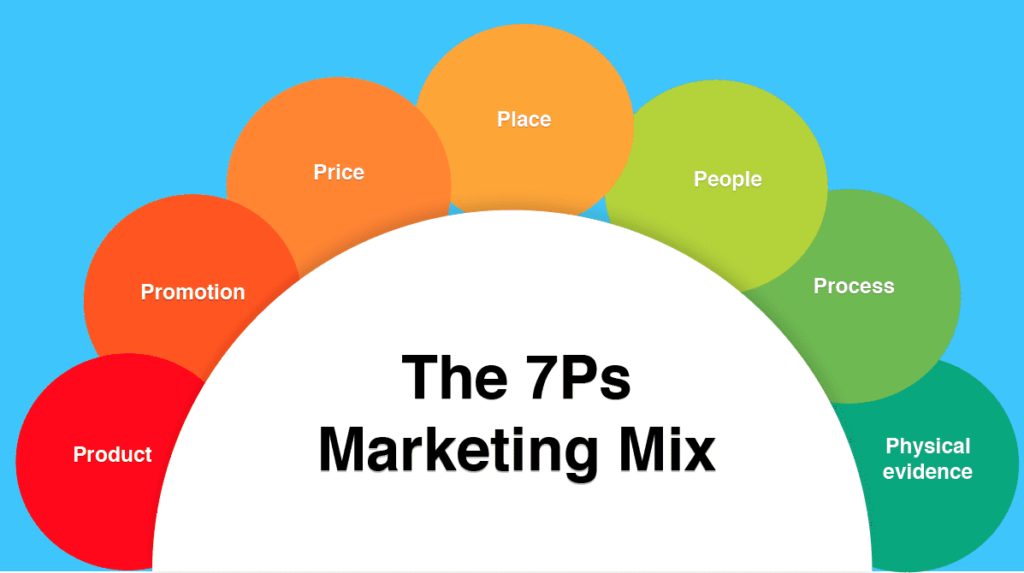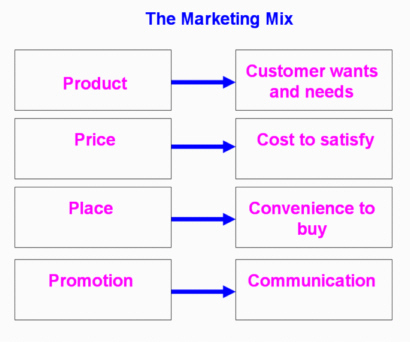The traditional marketing mix was conceptualized by Professor James Culliton, a marketing professor from the prestigious Harvard University, in 1948. It was further developed by E. Jerome McCarthy, who combined product, price, placement, and promotion strategies into a marketing theory that has remained significant for over 70 years. Since then, the marketing mix has evolved into the 7 P’s principle, which considers Product, Price, Promotion, Place, People, Packaging, and Process.
Today, in marketing, we refer to the 7 P’s as the developed marketing mix. Therefore, today, the Sixtygram marketing agency will explain the concept, components, and answer common questions about this theory.
What is the Marketing Mix?
Marketing Mix, translated into Thai as “ส่วนประสมทางการตลาด,” is the combination of Actions and Strategies. The Marketing Mix is thus an important marketing tool that businesses use to plan, promote, and advertise their brand or product. Currently, the marketing mix consists of the 7 P principles.

The 7Ps for Marketing Strategy
The concept of the traditional marketing mix had 4 Ps and has been developed to become known as the 7 P’s for current marketing strategies. Jerome McCarthy stated in his book “Basic Marketing: A Managerial Approach” that the 7P strategy refers to a meticulously designed combination of strategies and practices that businesses should use to drive and develop their successful products.
Initially, 4 Ps were derived from these components: 1.P from Product, 2.P from Price, 3.P from Promotion or sales promotion, and 4.P from Place. Later, 3 more Ps were added: 5.P from People, 6.P from Packaging, and finally, 7.P from Process, resulting in the “7 Ps” we refer to today.

It might be slightly complex for small business owners (SMEs) or marketing managers who are starting to learn how to create unique sales plans and propositions, or how to reach the right customers, especially on new platforms such as e-commerce or popular social media.
Therefore, the 7 Ps marketing strategy will provide you with business concepts and frameworks, using marketing plans and strategies necessary to effectively advertise to your target market. Additionally, you can consider the elements of the mix in your daily marketing decision-making process, aiming to attract the right audience to make your marketing campaign successful.
And here are the principles of the 7 P components of the marketing mix:
1. P from Product
Your customers are interested in only one thing: what your product or service can do that’s beneficial for them. For this reason, you should focus on making your product the best it can be and optimizing your product line to best suit your target group. This approach is called “product-led marketing“. Therefore, the marketing mix you should consider in terms of products and services includes:
- Design
- Product quality
- Product features
- Variety of product options
- Best packaging
- The role of the product in terms of marketing
To make it easier, we have 5 elements that will make your product consideration successful, taking into account the following principles:
- Let your product or service sell itself. Focus your marketing efforts on making consumers want to try what you offer, so they can learn its value for themselves.
- Position yourself as an expert (with your customers). Know your customers’ needs and use that knowledge to help communicate the value of your product.
- Always support the product. Position yourself as a good partner by creating product information content that meets the needs of your target customers. Eventually, they will be more likely to buy from you. This is also known as Content Marketing.
- Share user stories. Encourage happy customers to share their experiences and tell others why they like and use your brand.
- Focus on your product first. Before considering how to sell it, invest in product development and quality. After that, a good product will take care of the rest.
2. P from Price
There are many factors and strategies used to determine brand pricing, whether it’s:
- Setting product prices higher than competitors to create an impression and suggest that your products are of higher quality
- Setting product prices similar to competitors, then drawing attention to features or benefits that other brands lack or neglect
- Setting product prices lower than competitors to penetrate markets with dense buyers or attract consumers who consider value for money rather than wasteful spending
- Planning to raise prices after establishing the brand or lower prices to boost sales of new products
- Setting initial prices high to manage group sales or make promotions more interesting
Consider what you’re trying to accomplish with your pricing strategy, and how pricing will work with the rest of your marketing strategy. Therefore, you have questions to ask yourself when you’re about to sell products, including:
- Will you have higher-level products than before, which need to be priced higher?
- Do you need to be strict about costs from the first batch of products, or can you set lower prices to attract buyers and gradually raise prices as the business grows in the future?
- Do you have any ideas to offer sales promotions?
- How likely is it that people will question the quality of your product?How many times can you sell before customers think your product is overpriced?
- Do you see your brand as valuable or capable of becoming a high-end brand?
3. P from Promotion
Promotion or sales promotion is part of the Marketing Mix that the public can observe and receive the most attention. Whether it’s using television and print media advertising, Content Marketing, time-limited coupons or discounts, social media strategies, email marketing, display advertising, digital online strategies (SEM), search engine marketing (SEO), and general public relations, etc.
When using promotions through all channels, you can link all parts of the marketing mix together into a strategy. That creates a unified experience for your customer base excellently.
For example:
- Customers see promotions from storefronts, often using phones to check prices and read reviews before choosing to buy.
- Customers often look at the brand’s website to see whether it emphasizes brand value or product presentation more.
- The brand should request post-purchase reviews, and positive reviews should always appear on the site.
- Customers buy the product, and you send an automated thank you email.
You can use our examples to make the most of those channels to reach your target audience. Therefore, segment your promotional offers according to customer behavior, and test the response to various promotions for each specific group of interested parties and adjust marketing expenses accordingly. Remember that sales promotion is not a one-way trip. Customers expect you to care about their interests and offer excellent solutions when the time comes.
4. P from Place
Where will you sell your products? Similar to considering Product and Price for decision-making, using place is an important thing you need to consider as the foundation of marketing planning. This is not limited to just the physical store location. Try asking your business:
- Where can people find your products?
- Do people need to be able to visit the place?
- Will you get increased sales from marketing from your own e-commerce website, or will buyers look for you in third-party e-commerce markets?
- Do you want to talk directly to your customers while they buy, or do you want brokers or agents to service customers for you?
5. P from People
People refers to anyone who contacts your customers, whether directly or indirectly. Therefore, make sure you are recruiting capable people, not just in customer service or sales departments of the business.
Here’s what you can do to ensure your people will create the right results for your customers, if considered according to these observations:
- Develop good marketing skills for your people so they can understand and implement the marketing mix strategy according to your goals.
- Think about company culture and brand image.
- Focus on customer relationship management or CRM, which creates genuine connections and inspires loyalty to the business at a personal level for all your people.
6. P from Packaging
Product packaging can attract the attention of new buyers in dense markets and always add value to returning customers. Here’s how to improve your product packaging:
- Design for differentiation. Good design helps people quickly recognize your brand and can also emphasize specific product features. For example, if you’re a shampoo company, you can use different colors on packaging to label different hair types.
- Add valuable information to your packaging. Study the product and add value to the brand. Include clear instructions, interesting knowledge, or novel elements to surprise and satisfy customers with sharp ideas.
- Add more value. Make the packaging exceed expectations for your customers, and provide special branded, well-designed items along with the product to customers. For example, a free toothbrush from dentists, increasing the amount of snacks in a bag, or a free hairstyling guide from a famous hairstylist with hair dye.
7. P from Process
Prioritize overlapping processes systematically and orderly. Make your team’s work processes more relevant and smoother. When your employees can operate more smoothly and quickly, without focusing on working through complicated steps, they will pay more attention to customers. This affects the personal experience and excellent experience that customers will receive.
Therefore, ask questions about improving work processes as follows:
- Is the logistics (transportation) in your main distribution channels cost-effective?
- How do you manage your delivery schedules?
- Will your retailers or agents have enough products to serve?
- Do you have enough staff during busy times?
- Is the delivery service from your website reliable?
- If you receive more than one customer complaint about any process, identify what went wrong and find a way to fix it urgently.
FAQ: Marketing mix
Understanding the marketing mix and the 7 P principles may raise many questions. Sixtygram intends to answer frequently asked questions to help you understand and start creating your own marketing mix easily.
Examples of Marketing Mix

A good example of a marketing mix might be a convenience store. In this case, we will consider a convenience store with many networks that sell a variety of products, including fresh and ready-to-eat foods, tools, household and kitchen items, magazines, etc., using the 7 P principles as follows:
- P: Product – Most food and items are selected by inspectors from headquarters who have been carefully selected at every step.
- P: Price – Prices may be higher than local supermarkets, with the advantage of convenience, novelty, color, and fun to increase attractiveness.
- P: Place – The location should be easily accessible, so the location should be close to residential areas, shopping centers, educational centers, etc.
- P: Promotion – Advertising will be limited to building and store signs, social media pages, local city pages, etc.
- P: People – Organizing seminars and training for in-store sales staff, providing friendly service with pleasant speech and tone, showing respect to customers.
- P: Packaging – Designing shelves for easy understanding, products are arranged and packaged in a way that provides convenience and emphasizes utility.
- P: Process – Using computer software management systems, allowing sales staff to have time to assist customers and pay attention to recommending products correctly.

Another example might be a streaming service, using the 4 P principles as follows:
- P: Product – Quality video entertainment and convenient viewing access.
- P: Price – Free trial offers, premium packages, and flexible subscription levels.
- P: Place – Users’ computers or smartphones.
- P: Promotion – Advertising through various social media channels and platforms, including city billboards, magazines, etc.
Types of Marketing Mix
In reality, there are as many types of marketing mixes as there are businesses operating in the world. For easier understanding, here are 7 types of marketing mixes that are currently popular:
- Product Mix
- Product Life Cycle Mix
- Positioning Mix
- Service Mix
- Promotional Mix
- Channel Mix
- International Marketing Mix
If you look at it, presenting brand value and promotion may not seem to be directly in the 7 types of marketing mix as we exemplified.
However, if you look at the overall picture of your business, you will understand more easily. For example, a convenience store business is a Service Mix because convenience is the main value we will present, and streaming services are considered a Product Mix because quality video entertainment is the main value presented.
Conclusion
The marketing mix and the 7 P principles serve as basic tools for designing and implementing customer reach for all types of businesses. By creating guidelines with a rational marketing plan, you will ultimately develop products to understand from the existing foundation of the brand.
Incorporating the 7Ps and marketing mix into your marketing plan will help you understand business success to the next level, resulting in consistent approaches and plans. Learning the 7P principles and marketing mix helps to comprehensively understand how each component influences other components in the business. Aiming for a smooth customer experience, from product improvement to improving product value perception, each of the 7Ps should be carefully considered. For example, product pricing evaluation influences promotional strategies, while employee engagement affects operational efficiency. Optimizing both teams and resources is ultimately crucial for sustainable business growth.








